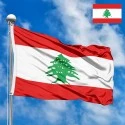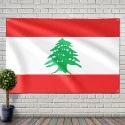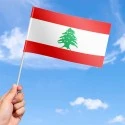The national flag of Lebanon is a profound and instantly recognizable symbol, embodying the enduring spirit, rich history, and unique identity of a nation often described as the "Pearl of the Middle East." With its striking cedar tree at the heart, the flag tells a story of ancient heritage, resilience, and the deeply held aspirations of its people for peace, sovereignty, and independence. It's a banner that proudly represents Lebanon's geographical beauty, its cultural diversity, and its historical significance in the Levant region.
Design and Dimensions
The flag of Lebanon features a horizontal triband design, characterized by three stripes of unequal width. The top and bottom stripes are red, while the central stripe is white and is twice the width of each red stripe. Centered on the white stripe is a prominent green cedar tree, depicted with its trunk extending from the bottom red stripe and its branches reaching towards the top red stripe. The official proportions of the Lebanese flag are 2:3 (height to width), giving it a balanced and dignified appearance.
Symbolism of the Colors and Elements
Each component of the Lebanese flag is laden with deep historical, cultural, and spiritual meaning:
-
Red Stripes (Top and Bottom): The two red stripes symbolize the blood shed by the Lebanese people in their struggle for independence and freedom. They represent the sacrifices made by martyrs throughout the nation's history, highlighting their courage and determination to resist occupation and secure their sovereignty. Historically, red also refers to the sacrifices during the fight against various foreign dominations.
-
White Central Stripe: The broad white central stripe represents peace, purity, and the snow-capped mountains of Lebanon. The majestic Mount Lebanon range, with its peaks often covered in snow, has historically been a source of inspiration and protection. White also symbolizes the purity of the Lebanese people and their aspirations for a peaceful future.
-
Green Cedar Tree: The green cedar tree at the center is the most iconic and significant emblem of the flag. The Lebanese Cedar (Cedrus libani) is an ancient and revered tree, deeply rooted in the country's history and geography. It symbolizes:
-
Longevity, steadfastness, and endurance: Cedar trees are known for their exceptional longevity and resilience, mirroring the enduring spirit of the Lebanese nation.
-
Holiness and eternity: The cedar is mentioned numerous times in the Bible, revered for its strength, beauty, and durability, symbolizing a sacred and eternal bond with the land.
-
Prosperity and hope: Its evergreen nature signifies eternal life, prosperity, and hope for the future.
-
Independence: Since the 18th century, the cedar has been used as a symbol of Lebanese independence and liberty, especially against Ottoman rule.
History of Creation and Adoption
The history of the Lebanese flag is intimately linked with the nation's path to independence from French mandate rule. While the cedar tree had long been a symbol associated with Lebanon, its inclusion on a national flag evolved over time. During the French Mandate era (1920-1943), a French Tricolour with a green cedar in the middle of the white stripe was used.
The current flag design was conceived by Members of Parliament during their detention by French Mandate authorities in Rachaya Citadel in 1943, as Lebanon moved towards independence. It was specifically designed to be distinct from the French flag, symbolizing a complete break from colonial rule while retaining the beloved cedar. The design was approved by the National Assembly on December 7, 1943, just days after Lebanon declared its independence on November 22, 1943. This swift adoption underscored the flag's importance as a symbol of the newly sovereign state.
Significance for the Inhabitants
For the people of Lebanon, the national flag is an incredibly potent and cherished symbol of their identity, resilience, and unity. In a country marked by its diverse religious and political landscape, the flag serves as a unifying emblem that transcends sectarian divisions. It embodies the collective memory of struggles for freedom and the unwavering hope for a brighter, more stable future.
The cedar, in particular, resonates deeply with Lebanese citizens, representing their deep connection to their ancestral land and their ability to endure and thrive despite adversity. The flag is proudly displayed on national holidays, at public gatherings, and in homes, serving as a constant reminder of Lebanon's sovereignty, its unique culture, and the shared aspirations for peace and prosperity for all its communities. It reinforces a sense of patriotism and the enduring spirit of a nation that refuses to yield.
Interesting Facts
-
Ancient Symbolism: The Lebanese Cedar has been a symbol of the land for thousands of years, revered by ancient civilizations like the Egyptians, Assyrians, and Babylonians for its timber and sacred significance.
-
Biblical References: The cedar is mentioned more than 70 times in the Bible, often associated with strength, majesty, and holiness, such as the "Cedars of Lebanon."
-
Designed in Detention: The current flag was designed by imprisoned Lebanese parliamentarians, adding a layer of poignant historical significance to its creation during the struggle for independence.
-
Distinct from Colonial Flags: The removal of the French blue stripe from the earlier mandate flag and the creation of a unique red-white-red design with the central cedar clearly marked Lebanon's break from its colonial past.
-
Symbol of Resilience: Despite decades of conflict and challenges, the cedar on the flag remains a powerful symbol of the Lebanese people's ability to "plant roots" and stand tall.
-
National Tree: The Lebanese Cedar is the national tree, a recognition of its profound cultural and historical importance to the country.
In the demonstration images, full-size flags are shown with proportions of 2:3, and hand-held flags with proportions of 1:2.








 Waving flag
Waving flag
 Sizes:
Sizes:
 Round flag
Round flag
 Sizes:
Sizes:
 Rectangular flag 2:3
Rectangular flag 2:3
 Sizes:
Sizes: